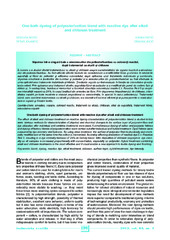One-bath dyeing of polyester/cotton blend with reactive dye after alkali and chitosan treatment
Чланак у часопису (Објављена верзија)
Метаподаци
Приказ свих података о документуАпстракт
The effect of alkali and chitosan treatment on reactive dyeing characteristics of polyester/cotton blend is studied in this work. Various methods for characterization of physical and chemical changes in the surface layer of polyester fiber and dye utilization after individual and combine treatments were used. A simultaneous dyeing of cotton and polyester fabrics and dyeing of factory blends of polyester/cotton were carried out after individual and hybrid treatment. Dyed fabrics were evaluated by dye intensity and fastness. By using alkali treatment, the surface of polyester fiber is physically and chemically modified and at the same time the cotton is mercerized, favorably affecting absorption of reactive dye C.I. Reactive Red 3, resulting to a dye intensity increase of 24% on factory blend. With deposition of chitosan biopolymer, dye intensity on all samples is increased proportionally with concentration, especially on polyester. Hybrid treatment combining alkali and chitosan treatmen...ts is the most effective and it could enable a new approach to textile dyeing and finishing.
Кључне речи:
blend / dyeing / reactive dye / alkali treatment / chitosan / surface layer / hybrid treatment / dye intensityИзвор:
Industria Textila, 2012, 63, 4, 190-197Издавач:
- Inst Natl Cercetare-Dezvoltare Textile Pielarie-Bucuresti, Bucuresti
Институција/група
Tehnološko-metalurški fakultetTY - JOUR AU - Ristić, Nebojša AU - Jovančić, Petar AU - Ristić, Ivanka AU - Jocić, Dragan PY - 2012 UR - http://TechnoRep.tmf.bg.ac.rs/handle/123456789/2001 AB - The effect of alkali and chitosan treatment on reactive dyeing characteristics of polyester/cotton blend is studied in this work. Various methods for characterization of physical and chemical changes in the surface layer of polyester fiber and dye utilization after individual and combine treatments were used. A simultaneous dyeing of cotton and polyester fabrics and dyeing of factory blends of polyester/cotton were carried out after individual and hybrid treatment. Dyed fabrics were evaluated by dye intensity and fastness. By using alkali treatment, the surface of polyester fiber is physically and chemically modified and at the same time the cotton is mercerized, favorably affecting absorption of reactive dye C.I. Reactive Red 3, resulting to a dye intensity increase of 24% on factory blend. With deposition of chitosan biopolymer, dye intensity on all samples is increased proportionally with concentration, especially on polyester. Hybrid treatment combining alkali and chitosan treatments is the most effective and it could enable a new approach to textile dyeing and finishing. PB - Inst Natl Cercetare-Dezvoltare Textile Pielarie-Bucuresti, Bucuresti T2 - Industria Textila T1 - One-bath dyeing of polyester/cotton blend with reactive dye after alkali and chitosan treatment EP - 197 IS - 4 SP - 190 VL - 63 UR - https://hdl.handle.net/21.15107/rcub_technorep_2001 ER -
@article{
author = "Ristić, Nebojša and Jovančić, Petar and Ristić, Ivanka and Jocić, Dragan",
year = "2012",
abstract = "The effect of alkali and chitosan treatment on reactive dyeing characteristics of polyester/cotton blend is studied in this work. Various methods for characterization of physical and chemical changes in the surface layer of polyester fiber and dye utilization after individual and combine treatments were used. A simultaneous dyeing of cotton and polyester fabrics and dyeing of factory blends of polyester/cotton were carried out after individual and hybrid treatment. Dyed fabrics were evaluated by dye intensity and fastness. By using alkali treatment, the surface of polyester fiber is physically and chemically modified and at the same time the cotton is mercerized, favorably affecting absorption of reactive dye C.I. Reactive Red 3, resulting to a dye intensity increase of 24% on factory blend. With deposition of chitosan biopolymer, dye intensity on all samples is increased proportionally with concentration, especially on polyester. Hybrid treatment combining alkali and chitosan treatments is the most effective and it could enable a new approach to textile dyeing and finishing.",
publisher = "Inst Natl Cercetare-Dezvoltare Textile Pielarie-Bucuresti, Bucuresti",
journal = "Industria Textila",
title = "One-bath dyeing of polyester/cotton blend with reactive dye after alkali and chitosan treatment",
pages = "197-190",
number = "4",
volume = "63",
url = "https://hdl.handle.net/21.15107/rcub_technorep_2001"
}
Ristić, N., Jovančić, P., Ristić, I.,& Jocić, D.. (2012). One-bath dyeing of polyester/cotton blend with reactive dye after alkali and chitosan treatment. in Industria Textila Inst Natl Cercetare-Dezvoltare Textile Pielarie-Bucuresti, Bucuresti., 63(4), 190-197. https://hdl.handle.net/21.15107/rcub_technorep_2001
Ristić N, Jovančić P, Ristić I, Jocić D. One-bath dyeing of polyester/cotton blend with reactive dye after alkali and chitosan treatment. in Industria Textila. 2012;63(4):190-197. https://hdl.handle.net/21.15107/rcub_technorep_2001 .
Ristić, Nebojša, Jovančić, Petar, Ristić, Ivanka, Jocić, Dragan, "One-bath dyeing of polyester/cotton blend with reactive dye after alkali and chitosan treatment" in Industria Textila, 63, no. 4 (2012):190-197, https://hdl.handle.net/21.15107/rcub_technorep_2001 .



